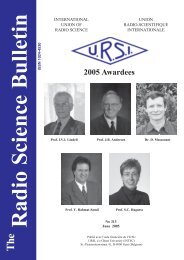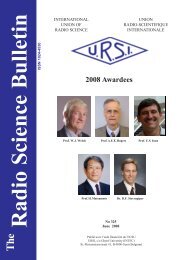December 2012 - URSI
December 2012 - URSI
December 2012 - URSI
Create successful ePaper yourself
Turn your PDF publications into a flip-book with our unique Google optimized e-Paper software.
Despite the huge overall dimensions of the book,<br />
there are still some remaining blind spots:<br />
• Target imaging is badly missing in the chapter dealing<br />
with RCS, where target images are shown and described –<br />
including such artifacts as air-intake multipath – without<br />
any description of the underlying imaging principle.<br />
Radar holography could be explained in a paragraph,<br />
which would also have well-complemented the SAR<br />
imaging chapter.<br />
• Clutter characteristics are not very detailed (curiously<br />
enough for this team of authors from Georgia Tech,<br />
which have a renowned expertise in that area), especially<br />
concerning surface-clutter spectra (ground and sea),<br />
and the effects of multipath and shadowing. Similarly,<br />
airborne clutter distribution and its characteristics, and<br />
associated target extraction, are not very well covered.<br />
• Polarization is mentioned in a very cursory way, without<br />
any detailed physical description to help the reader<br />
to understand the use (weather radar) and limitations<br />
(for target classification). Basic physical phenomena,<br />
signal decomposition, and essential clutter and target<br />
characteristics should be provided in such a detailed<br />
introductory course.<br />
Considering the applicability of using this book as a<br />
textbook in universities and training schools, the answer<br />
is largely positive – and this will indeed be the preferred<br />
textbook of this reviewer for the years to come. The<br />
explanations from high level to details, the vast corpus<br />
of references, the high readability of the text, the fine<br />
balance between intuitive description and precise analytical<br />
formulations, are very significant assets for that use.<br />
However, some of the critical areas that are known as chronic<br />
weak points for students are not perfectly covered here:<br />
A detailed physical explanation of the important issue<br />
of Doppler, as a phase shift from pulse to pulse, would<br />
have been appreciated in Chapter 1, since it is difficult to<br />
grasp for students and essential in signal processing. The<br />
definition of radar cross section (Chapter 2) should mention<br />
the isotropic diffraction assumption, not always easy to<br />
grasp for students. there is a very abrupt introduction of<br />
synchronous detection (Chapter 3), and I and Q channels.<br />
This issue, often poorly understood by students, should be<br />
very clearly described (perhaps in an appendix, since it is<br />
not specific to radar applications).<br />
The paragraph on basic reflection physics (Chapter 6)<br />
should also roughly describe the available modeling<br />
techniques, from Rayleigh to asymptotic methods, to help<br />
the reader in grasping the underlying physics: diffraction,<br />
creeping waves, resonance, etc. In this paragraph, the<br />
description of polarization effects is also very limited. There<br />
is no description of circular compared to linear polarization,<br />
the effects on drops, edges, surface waves, etc. In Chapter 15,<br />
the key notion of integration gain is not clearly defined:<br />
is it the gain in signal-to-noise ratio, or the gain required<br />
for a certain detection quality ( P d , P fa ) level? This is<br />
essential for a good understanding of power budgets, and<br />
difficult to grasp for beginners. Moreover, if it is indeed<br />
defined as signal-to-noise ratio improvement, coherent and<br />
non-coherent integration are strictly equivalent: summing<br />
N independent samples improves the signal-to-noise ratio<br />
by a factor of N, whatever the underlying distribution. In<br />
Chapter 15, the description of detection issues on Gaussian<br />
probabilities is very misleading, since in practice, the<br />
quantities submitted to threshold are positive quantities!<br />
Why not use the correct probabilities and curves, as in the<br />
following chapter? The whole detailed discussion with exact<br />
numerical values is pointless, since radar never detects<br />
without some kind of envelope detection.<br />
In Chapter 17, rather than the autoregressive model,<br />
which has specificities making it touchy to use by beginners,<br />
it would have been useful to mention here Capon or MVDR<br />
spectral analysis, which can be used very easily, and can<br />
generally be used preferably to the standard DFT!<br />
Chapter 18, on radar measurement (range, angle,<br />
etc.) is essentially an accumulation of non-demonstrated<br />
formulas, roughly equivalent for different specific cases.<br />
For such a book dealing with principles, it would be more<br />
useful to give demonstrations of the basic principles and<br />
formulas. This is especially true for the very frustrating<br />
description of monopulse. There is no explanation of the<br />
necessity of channel (maximization of <br />
2<br />
), or of<br />
the equivalence between phase and amplitude monopulse,<br />
or of the underlying phenomenology: alignment along<br />
the wavefront. The same is true for the multiple-targets<br />
situation, where only a very specific example is given, rather<br />
than a general view. This chapter clearly does not address<br />
the same objectives as the rest of the book. This specific<br />
aspect of monopulse, also addressed in a very cursory way<br />
in Chapter 9 on antennas, though certainly important for<br />
the students and for many engineers, is definitely a weak<br />
point in this book.<br />
In Chapter 20, it should be clearly mentioned – and<br />
emphasized – that RCS is proportional to the square of the<br />
ambiguity function At , f d , meaning that the sidelobe<br />
2<br />
requirements are in terms of A : there is a very frequent<br />
confusion looming there.<br />
Conversely, some approaches will certainly be<br />
appreciated by beginners, and some experts. In Chapter 2,<br />
a nice example of system analysis is given for the influence<br />
of antenna beam squint on power budget: lengthy, but<br />
efficient. The clear description of data cubes in Chapter 8<br />
is welcome here, and will certainly prove useful for many<br />
students. Chapters 11, 13, and 14 include very well designed<br />
high-level descriptions of signal-processing matters: the<br />
clarity of these chapters is certainly a strong point of this<br />
book. In Chapter 16, a careful use of baseline examples is a<br />
nice way to help the beginner in grasping the importance of<br />
false alarms. Mentioning clutter-fill pulses, in Chapter 17,<br />
32 The Radio Science Bulletin No 343 (<strong>December</strong> <strong>2012</strong>)
















